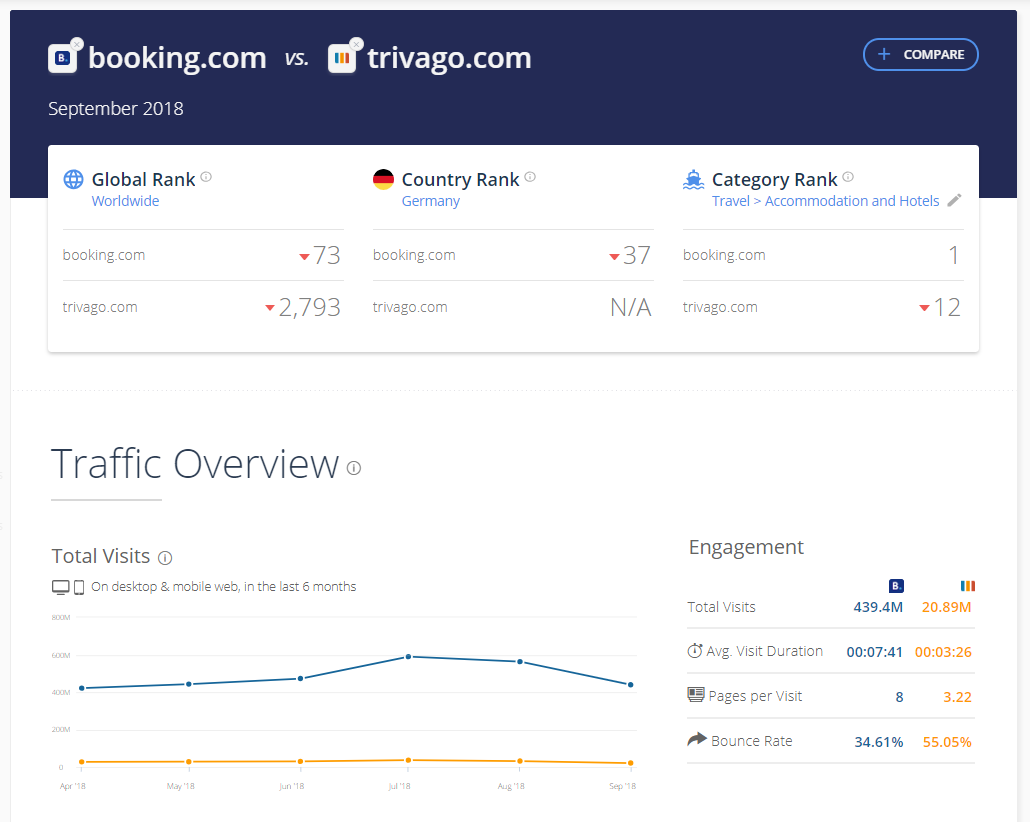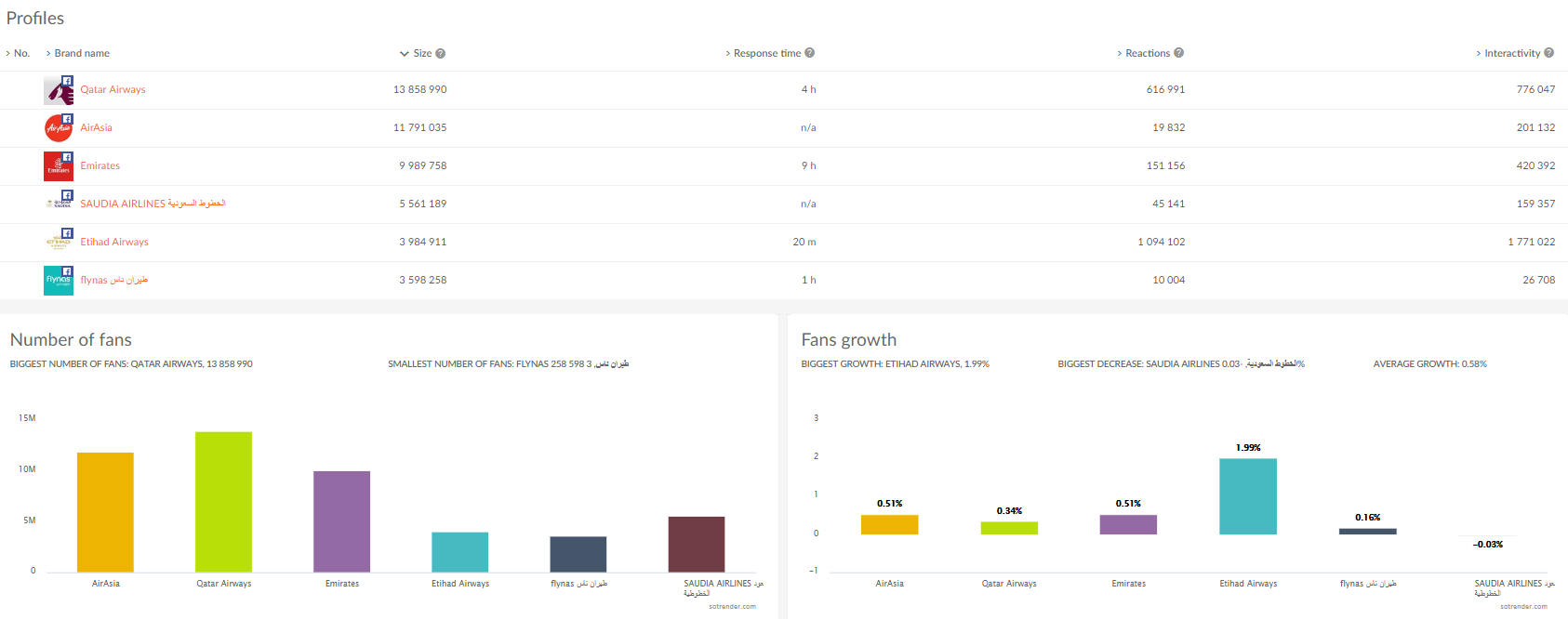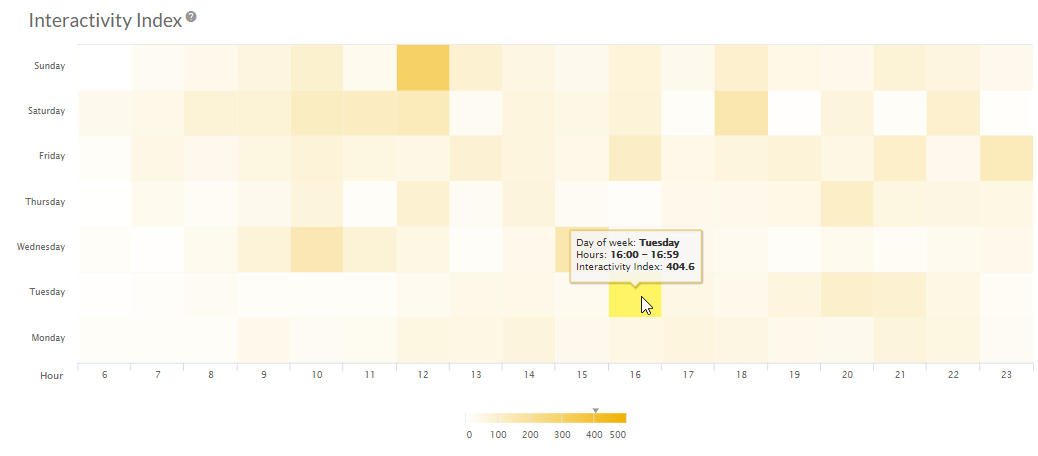Who doesn’t want to know their competitor’s every secret?
And did you know that you can uncover at least a few of their secrets? Easily and quickly? That’s right, in marketing (and business in general), there’s a special formula for that known as benchmarking. Even if you’re unfamiliar with the term, it’s not as complicated as it might seem.
We’re here to guide you through the benchmarking process and help you get the most out of it.
Let’s start from the very beginning.
What is competitive benchmarking?
According to the definition:
A measurement of the quality of an organization’s policies, products, programs, strategies, etc., and their comparison with standard measurements, or similar measurements of its peers.
What are the objectives of competitive benchmarking?
The main objectives of benchmarking are:
- To determine what and where improvements are called for.
- To analyze how other organizations achieve their high-performance levels.
- To use this information to improve performance.
To put it simply, we can say that benchmarking is the act of comparing… anything. It usually relates to business but it can be applied to any part of our lives as well.
If you are more into the historical aspects and managing / CEO approach, you’ll love what was published by Harvard Business Review called “Measure Yourself Against the Best”.
Benchmarking is a process
It’s one of the first things which you should be aware of. Benchmarking is a process. It’s not something that’s done once and is done for good. The world changes, trends change, best practices change.
As long as your business develops and you introduce improvements, your situation changes along with it. Which means you’ll soon have to start benchmarking again.

Benchmarking is a process, source
Why should each brand benchmark against competition?
Why should you even consider benchmarking? What will you get out of it? After all, this is another task to put on your to-do list. Since time is always lacking, it’s necessary to be aware of all the advantages we get from additional tasks.
So, why benchmarking?
The main advantages for any company are:
- It shows you where you stand and what to do to assure future growth.
- You’ll know your position on the market (by comparing to your competitors you see how you’re doing and what to improve).
- You can focus on the best practices in your industry and see what works and what doesn’t.
- You get to know your audience better.
- It helps you stand out of the crowd and outperform your competitors.
- It helps you foster ideas and inspiration while avoiding common pitfalls that other companies make.
In general, competitive benchmarking makes it possible to understand the market you are in and the audience you’re talking to.
How can you benchmark?
Now onto the practical stuff. How do you benchmark? What should you benchmark? How can you conduct such a process when there are so many companies to compare to? And so much data!
Let’s focus on social media and digital marketing for now. After all, we’re talking to marketers here 😉
In general, benchmarking can be done in several ways:
- You can do it manually by observing the steps of your competitors on social media – this method is limited.
- Track your growth metrics by checking e.g. Google Analytics, Facebook Insights.
- Track and measure your KPIs.
- Use external tools, e.g. Sotrender (it offers analytics for accounts you aren’t involved in, e.g. competitor profiles).
- Monitor public data and compare your results to others.
- Observe trends in the industry and react to them.
What aspects of a business can be compared? Every aspect, actually. The only limitation is the data and information you’ll have access to. What does that mean? For example, you probably don’t have access to the budget plans and other confidential documents of your direct competitors.
So, in practice, where can I take the data from?
This is the part which raises the most doubts. Where should we look for benchmarking data? Well, in these places for example:
- Public data provided e.g. by governmental institutions.
- Industry overviews.
- News articles.
- Seasonal researches.
- Press releases.
- Various tools which enable the analysis of competitor profiles (like e.g. Sotrender).
Generally speaking, search the internet and you’ll find quite a lot public data you can use.
You can benchmark quantitative aspects (in simple words: numbers) as well as what is unmeasurable, for example, the best practices or tone of voice used in each brand’s communication.
You can benchmark every department in your company and every aspect of it, even the smallest ones. You can start broadly with marketing and then dig deeper into e.g. digital marketing -> social media -> Facebook. It’s all up to you. You can start with what’s easiest, just to get the hang of benchmarking and see what you can get out of it. Or start with what’s most important, focusing on crucial aspects first.
![]()
Who should you benchmark against?
Another important question: who can I compare my brand to? Basically, benchmarking is done towards competitors. But you don’t have to limit yourself! Your brand can also be benchmarked also:
- Key business drivers – industry leaders.
- Local companies – direct competitors.
- Other companies outside the sector regarding specific issues, e.g. customer service.
- Industry norms, statistics, public data.
- Any brand or business you want to compare to.
It also depends on what you want to find out and achieve with benchmarking. There’s a lot of freedom when it comes to benchmarking!
Here’s how it might look from this perspective:
- For a general and broad overview -> it’s good to analyze companies of every size, from small businesses up to corporations.
- When you start a business -> direct and local competitors to analyze their offers, strategies and performance, to know what you can aim at.
- For developing your business -> companies which are more developed than yours but aren’t the biggest players (not international companies) since the gap between you and the biggest companies might still be too big.
To be more precise, here are some things you can benchmark:
- Quality of life (e.g. cities)
- Delivery speed (e.g. e-commerce)
- Customer service / customer satisfaction
- Engaged users / fans growth / reactions (on social media channels)
- Financial metrics
- Healthcare costs (governments/ states)
- Open rates/ click rates (email marketing)
- Website traffic
How to benchmark various aspects of marketing performance
We’ve discussed the theory, now let’s get more into practice and our – marketers – perspective.
What can we compare? How? What tools can we use? There’s a lot to unpack here, so let’s get right to it.
We analyzed the most important aspect of our online presence, with appropriate online tools:
Content analysis
For content analysis and online performance, here at Sotrender we usually use Ahrefs. As you can see below, Ahrefs offers a bunch of various metrics and data about a selected website and its content (including e.g. top pages or top keywords).

Ahrefs
Ahrefs offers broad and comprehensive marketing analytics, including SEO, link building, website traffic, PPC campaigns and more.
Some other similar SEO tools are SEMrush, Moz or BuzzSumo.
Website traffic
For analysing website traffic and the performance of different sites, SimilarWeb is very useful. Even the free version will offer you useful stats and data. For more in-depth analysis, you can also use the Pro version.

SimilarWeb
Online opinions & comments
For tracking specific brands (by name) or phrases, use Brand24. It’ll help you keep an eye on what your competitors do, what is being said about them, and monitoring any topic that interests you, such as Social Media Marketing or Social Media Optimization:

Brand24
This is, as we mentioned earlier, a non-quantitative analysis. It’s great for understanding the sentiment about each brand and the attitude of their customers towards it.
Social media benchmarking
Let’s now move on to social media analysis and break the process down into a practical – step by step – guide.
How do I start competitive benchmarking with Sotrender?
You might have heard of Sotrender and identify it with social media analysis. What some of you may not know is that Sotrender also offers a separate benchmarking section.
You can start using Sotrender for benchmarking purposes in a few easy steps.
- Add your own profile(s).
- Check detailed analytics for them to have an overall idea of how your profiles are performing.
- Add your competitors’ profiles.
- Create a ‘benchmarking group’ – add a few profiles to your account and make a group that’ll reveal the best brand secrets.
Let’s move to practice!
Growth rates
Growth rates are basic stats you should monitor, as they inform you of how fast each brand is growing.

If one brand is growing exceptionally faster than others, you’d better check out what they’re focusing on and what’s the secret standing behind their success.
Top content
For analysing what is trending on social media, however, take advantage of Sotrender’s content section.

Top posts
With the Top posts overview, you can immediately know which posts were rocking social media over the selected time period. Get some inspiration for your future communication 😉
Types of content
Do you know the types of content posted by your competition? Are they more into photos or videos, for example?

Post types
Analyze their long-term strategy and draw conclusions to improve your performance.
User activities
Are users engaged in your competitors’ communication? How? Do they only react with a like in their posts or do they interact more by commenting or sharing?

User activities
If you have fewer comments and shares than your competitors, you should analyze what you post. Your competition is likely posting something more interesting and relevant to your target audience.
Engagement rates
Engagement is one of the most important metrics when it comes to marketing effectiveness. That’s why it’s crucial to properly monitor it.
A perfect example here is the Interactivity Index (for Facebook; Activity Index for other channels), which is an aggregated metric presenting engagement on each profile. There’s no better way to analyze a profile’s performance over a longer perspective.

Interactivity Index, comparison in Sotrender
Apart from comparison groups, you can also analyze each profile separately to access even more in-depth data.
Once you know what your competitors are posting on social media (you can find it in the top posts overview), you should also be aware of how often they post and at what time.
One chart, which is especially worth analyzing, is the engagement heat map (based on Interactivity Index indicator for Facebook and Activity Index for other channels):

Interactivity Index
The heat map shows you the best time to post. And since it’s based on individual, historical data from each brand, the results are 100% reliable.
Once you know your competitors gather the highest engagement, for example, on Tuesday in the afternoon, use this knowledge in practice and outperform them.
Time to sum up.
You can track competitors with Sotrender to:
- Access social data for any brand.
- Benchmark your daily activities towards your direct competitors.
- Monitor other brands’ performances to understand the market and trends.
… and what is even more important is that at Sotrender you can create comparison reports with all this data. With a few easy steps you can compare various brands to each other, gather the most important metrics, and impress your boss or client with comprehensive research delivered in the form of a brief.
If you are more into paid campaigns, remember the option to track Facebook Ads of any Facebook Page you want in Facebook Ads Library.

Info about McDonald’s active ads in Ads Library
It’s an easy way to find out:
- If your competition is running paid campaigns.
- What creation they’re using.
- How they communicate (are they speaking to one buyer persona or various ones).
- How they present values and reasons to use their offer.
- What tone of voice they use.
Conclusion
What we have to mention at the very end is… don’t feel discouraged with what you find. You have to be aware from the beginning that what you discover with competitive benchmarking can be overwhelming. But all that should do is spark even more motivation! Your competitors might be rocking what they do, but the sky’s the limit. Who knows if one day you’ll achieve even more success?
Give your findings a fresh look, make an in-depth analysis, decide what’s most important to focus on, create an action plan and strategy, and…
…roll up your sleeves and get to work on your new and fresh ideas!
We hope that after reading our text and benchmarking your business you will be motivated and inspired like never before!




